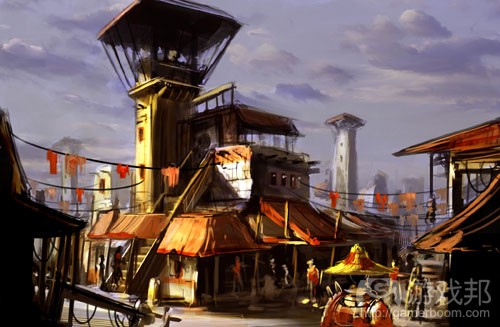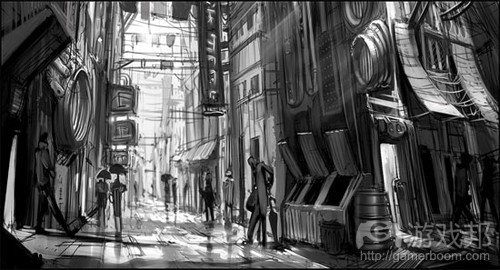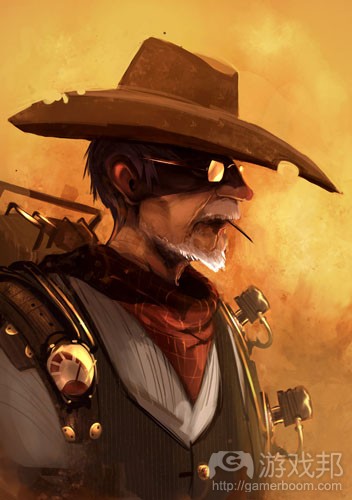Matt Kohr谈在校学生成为游戏概念美术师的过程
作者:Brenda Brathwaite
Matt Kohr是莎凡娜艺术设计学院(简称SCAD)的一名学生,并希望自己毕业后能够成为一名电子游戏概念美术师。为了实现这个梦想他已经采取了一些行动,如在学校没课的时候或者在暑假期间参加一些与之相关的社会实践。在Brenda Braithwaite教授(游戏邦注:她是是Kohr在“应用游戏设计”课程中的老师,这门课模拟了真实的游戏产业环境)主持的面谈中,Matt讲述了自己作为美术学生的发展过程,以及至今为止取得成功的秘诀。
概念美术师总是被当成美术设计领域一个“神圣”的职位”。而作为一名初露头角的概念美术师,你是否因为这样而感到害怕,或者因此受到激励?
不可否认我真的对此又畏惧又憧憬。有时候,我会害怕是因为概念美术师总是缺少足够的容身之处,而我也因为圈内激烈的竞争而倍感压力。但是,因为我有幸能够亲眼目睹概念美术在游戏开发工作室中的作用。在开发团队中,概念美术师的工作能够激励别人,并帮助他们明确前进目标。如果我的作品能够让别人停下手中的工作而说道:“是的!这是就是我们所需要的!”,那么我的一切努力便都是值得的。
从最初的理念到最后的概念,你需要经历何种过程?
很多美术师所面临的一个最困难的问题便是:“我应该画些什么?”幸运的是,概念美术师并不用去思考这个问题,因为游戏开发团队中从不会缺少灵感。
除了《Cowboy Cave》,我现在正与SCAD的同学们和游戏设计师Will Miller合作,致力于开发一款独立游戏。Will会给我分配任务,诸如“设计一辆坦克。而且我希望这辆坦克能有自己的个性。也许你可以先画出坦克的外表或者其它位置。”收到如此含糊的描述后我便开始收集任何有关的视觉资源的材料了。
基于现有的图像和照片,我创造了一个很小的“缩略图”,以此去判断坦克的构造。如果我能够赋予这张缩略图个性,那么我就算几乎完成了Will的委任了。而如果这个概念的结构已经很明了,并且也具有趣味性,那么我便可以将其放大。而剩下的工作便是对此进行完善。
虽然还是学生,但是你曾利用一些空闲或者暑假时间在游戏行业中体验了概念美术师的工作。而这些工作体验对于你有何帮助?
如果你真的想要进入这个行业,学校并不能提供给你所有的帮助。在学校,所有的学生都会在每学期结束前一周蜂拥至电脑教室“抱佛脚”,在这里,每个人都习惯在顶着截止日期的压力疯狂加班加点。看来这的确是个不错的工作环境!但是,这种倾斜式的能量爆发在绝大多数课程中一个学期只会出现一次。而游戏工作室却与之不同,因为在这里,你的头脑每天都需要高速运转加热,不能停歇。
每天工作9个小时有助我成为一名优秀的艺术家。而与充满优秀开发者的团队一起工作能让我的工作变得更加有趣。
有些人对于你首次接触这个行业时的情形很感兴趣。你能否跟我们分享你在那时候的想法和心情?
在我刚上大学的头一年,我有幸参加了Hi-Rez工作室的午餐会,并听取他们对于即将发行的大型多人电脑在线游戏《Global Agenda》的介绍。幸运的是,Hi-Rez也参加了SCAD的年会——“游戏开发者交流会(GDX)”。他们在会上表示正在寻找一些优秀的毕业生加入团队,而我作为一名没有任何经验的在校生,直接忽视了这一要求向制作人毛遂自荐。
虽然我忘记带自己的文件夹,但是我告诉这位制作人可以在本周末访问我的网站。但在我说这句话的时候我还未拥有自己的网站。不过一周后,我就让自己的网站上线了。
我们在后来交换了电子邮件地址,我也向其承诺无论如何都会尽自己所能帮助他们。正是因为主动和热情才会让我获得第一次实习机会,也因此开启了我在大学时期的职业生涯之门。
对于那些同样也梦想着成为概念美术师的在校生,你是否能提供给他们一些建议?
你必须热爱设计,在工作中投入百分百的努力。不要轻易放下你手中的铅笔。说实话,学校的课程并不能帮助你实现目标。你需要做的便是寻找一个团队,加入他们,并参与一款游戏或模型的开发。最好的经验总是来自于课外体验。而且你还应该充满想象力。如果你拥有足够丰富的实践经验,那么技术将不再是阻碍你的重要因素,而你也将可以全身心地投入于创造中。
同时,你还需要加入一些在线社区,如“www.ConceptArt.org”,因为在这些网站中你可以了解一些优秀的游戏,并获得一些有价值的反馈。
我想没有比成为一名有追求的美术师更棒的事了。网络中充满各种艺术社区和免费媒体。你甚至可以在DVD上观看美术师叙述他的整个创造过程,例如《Gnomon Workshop》系列。如果你真正喜欢这项工作,你就需要主动去吸引别人的关注,因为你从来不会知道什么时候才会有机会自我推荐。
文章中的概念美术图像是来截自Matt Kohr在应用游戏设计课程中的开发项目《Cowboy Cave》(暂定名称)。
SCAD毕业生及该游戏项目主管David McDonough对《Cowboy Cave》的描述如下:
“我们的《Cowboy Cave》创作灵感来自于一个单一的视觉主题:一个牛仔在山洞里进行探索。随后我们便带着一些设计原则,以及我们称之为‘简单,迅速,没有文字的界面,数字,菜单’的核心元素,还有能够推动其它系统的单一创造性核心机制而开始我们的游戏创造。”
“虽然现在这款游戏只算完成了一半,但是却已经形成了一个快节奏的第三人称策略射击游戏的轮廓了,游戏是关于一个灰色头发的坚强老牛仔在巨大的山洞中进行探索,并且在他自己发明的机器人伙伴的帮助下一步步前行。我们的技能系统是围绕着一些简单的小游戏进行设计,让玩家们能够在游戏中改造自己的机器人伙伴,如此玩家将能够在应对游戏挑战时创造出属于自己的不同机器人,或者以此补充玩家不同的游戏风格。”
《Cowboy Cave》项目主管是David McDonough,设计者是Laura Beukema 和Johnny Costello,美工是Ashley Waldbaum和Drew Harrison,而Matt Kohr则是主要概念美术师。
游戏邦注:原文发表于2011年6月7日,所涉事件和数据均以当时为准。(本文为游戏邦/gamerboom.com编译,拒绝任何不保留版权的转载,如需转载请联系:游戏邦)
Becoming a Game Concept Artist
Brenda Brathwaite
Matt Kohr is a student at Savannah College of Art and Design who wants to work as a concept artist in the video game industry. He’s already nabbed a few gigs doing some artwork part-time while in school and during his summer break. In this interview conducted by professor Brenda Braithwaite (who teaches a course Kohr is enrolled in called Applied Game Design class, which mimics the game industry environment), he explains his artistic process and the secret to his success so far.
Prof. Brenda Brathwaite: The concept artist is often considered the holy grail of art positions. As a budding concept artist, does this intimidate or inspire you?
Matt Kohr: It’s a little bit of both. Sometimes I get scared because there aren’t many concept art positions to go around, and I’m overwhelmed by the portfolio competition. Luckily, I’ve had the opportunity to see the influence of concept art in the studio environment. In a team setting, seeing a strong piece of concept art can really inspire everyone and give them a strong goal to progress toward. When one of my pieces causes someone to stop and say, “Yes! That is what we need to make,” it makes all the effort worthwhile.
BB: What is your process from initial idea through to final concept?
MK: As many artists know, one of the hardest questions is “What should I draw?” Luckily, the concept artist is immune to this question — a game development team is never short on ideas to be illustrated.
In addition to Cowboy Cave [images shown], I’m currently working on an indie game with fellow SCAD student and game designer Will Miller. He will give me an assignment like, “Give me a tank. I want the tank to have a personality. Maybe give the tank a face or something.” I take this cryptic prompt and begin to gather visual source material.
Working from existing art and photographs, I create small “thumbnail drawings” to decide how the tank is shaped. Once I get a thumbnail with personality, I’m practically done. If the shape is clear and interesting at one inch wide, it will work large scale. The rest is polish.
BB: As a student, you’ve spent summers and some time while in school working in the industry as a concept artist. How has this industry experience benefited you?
MK: School can’t totally prepare you for the industry. At school, the week before finals, students flood the computer labs. Everyone feverishly works under their deadline, giving feedback to one another. It’s a great working environment! Communal energy of that sort only happens once per term in most classes, though. A game studio gets that every day.
The simple act of working for nine hours every day makes me a stronger artist. Doing it surrounded by a team of talented game developers makes it fun.
BB: Others are likely interested in how you got an industry gig in the first place. Can you share how that came to be?
MK: My freshman year, I found myself in a lunch meeting with Hi-Rez Studios and listened to them describe their upcoming PC MMO Global Agenda. Luckily, they were attending our annual conference here at SCAD, The Game Developers eXchange (GDX). They said they were looking for graduating seniors, but being a defiant freshman, I totally ignored them and introduced myself to the producer.
I forgot to bring a portfolio, but told him to visit my web site at the end of the week. When I told him that, though, I did not actually have a web site! A week later, however, I did.
When we exchanged emails after that, I made it quite clear that I would help in any capacity — and at any price. I told him I would work for free. Some combination of passion and portfolio landed me a summer internship, which led to a fantastic working relationship throughout college.
BB: What advice do you have for aspiring concept artists still in college?
MK: You have to love designing, and do all the hard work yourself. Never put your pencil down. Seriously. School work is not enough to get you where you want to be. Find a team and make a game or a mod. All of the best work comes from extra-curricular drawing. Always be imagining. If you practice enough, the technical part will stop hindering your art, and you can focus on being creative.
Also, make sure to be a part of online communities such as www.ConceptArt.org. These sites are great places to see how the pros work and to get valuable feedback.
There has never been a better time to be an aspiring artist. The internet is alive with art community and free media. You can even watch DVDs where artists create entire works while narrating their process, such as the Gnomon Workshop series. So, if you really enjoy it, put in the hours drawing, and put yourself out there. You never know when you might need to show off your portfolio.
The concept art shown in this article comes from Matt Kohr’s Applied Game Design project, Cowboy Cave (working title), except the black and white image, which is also by Kohr but for another project.
SCAD graduate student and project lead David McDonough describes how Cowboy Cave came to be:
“Our project, Cowboy Cave, stemmed from a single visual theme: a cowboy exploring a cave. We started with a number of design principles, or ‘kernels’ as we call them: simplicity, speed, interfaces without words, numbers, or menus, and a single innovative core mechanic that drives all other systems.
“Still only half complete, the game has taken shape as a fast-paced, third-person tactical shooter-platformer focused on a grizzled, tough-as-nails old cowboy exploring this massive cave system with the aid of a ramshackle robotic sidekick of his own invention. Our crafting system, designed around a number of simple, linked mini-games, allows the player to re-invent and re-configure their sidekick’s abilities on the fly; to create individually-tailored versions of the sidekick in response the game’s challenges or to complement the player’s own playing style.”
The Cowboy Cave team is David McDonough, designers Laura Beukema and Johnny Costello, and artists Ashley Waldbaum and Drew Harrison. Matt Kohr is the primary concept artist. (source:gamecareerguide)










































 闽公网安备35020302001549号
闽公网安备35020302001549号